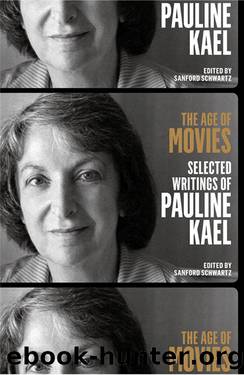The Age of Movies by Pauline Kael

Author:Pauline Kael [Kael, Pauline]
Language: eng
Format: epub
ISBN: 978-1-59853-171-8
Publisher: Library of America
Published: 2011-04-14T16:00:00+00:00
:: Killing Time
Clint Eastwood isnât offensive; he isnât an actor, so one could hardly call him a bad actor. Heâd have to do something before we could consider him bad at it. And acting isnât required of him in Magnum Force, which takes its name from the giantâs phallusâthe long-barreled Magnum .44âthat Eastwood flourishes. Acting might even get in the way of what the movie is aboutâwhat a big man and a big gun can do. Eastwoodâs wooden impassivity makes it possible for the brutality in his pictures to be ordinary, a matter of routine. He may try to save a buddy from getting killed, but when the buddy gets hit no time is wasted on grief; Eastwood couldnât express grief any more than he could express tenderness. With a Clint Eastwood, the action film canâindeed, mustâdrop the pretense that human life has any value. At the same time, Eastwoodâs lack of reaction makes the whole show of killing seem so unreal that the viewer takes it on a different level from a movie in which the hero responds to suffering. In Magnum Force, killing is dissociated from pain; itâs even dissociated from life. The killing is totally realisticâhideously, graphically soâyet since itâs without emotion it has no impact on us. We feel nothing toward the victims; we have no empathy when they get it, and no memory of them afterward. As soon as one person gets it, weâre ready for the next. The scenes of carnage are big blowoutsâparties for the audience to gasp at in surprise and pleasure.
At an action film now, it just doesnât make much difference whether itâs a good guy or a bad guy who dies, or a radiant young girl or a double-dealing chippie. Although the plots still draw this distinction, the writers and the directors no longer create different emotional tones for the deaths of good and bad characters. The fundamental mechanism of melodrama has broken down, I think: the audience at action pictures reacts to the killing scenes simply as spectacle. A tall, cold cod like Eastwood removes the last pretensions to humane feelings from the action melodrama, making it an impersonal, almost abstract exercise in brutalization. Eastwood isnât very different from many of the traditional inexpressive, stalwart heroes of Westerns and cops-and-robbers filmsâactors notoriously devoid of personalityâbut the change in action films can be seen in its purest form in him. He walks right through the mayhem without being affected by itâand we are not cued to be affected, either. The difference is a matter of degree, but itâs possible that this difference of degree has changed the nature of the beastâor, to put it more accurately, the beast can now run wild. The audiences used to go mainly for the action but also to hate the ruthless villains, sympathize with the helpless victims, and cheer on the protector-of-the-weak heroes. It was the spaghetti Westerns (which made Clint Eastwood a star) that first eliminated the morality-play dimension and turned the Western into pure violent reverie.
Download
This site does not store any files on its server. We only index and link to content provided by other sites. Please contact the content providers to delete copyright contents if any and email us, we'll remove relevant links or contents immediately.
| Coloring Books for Grown-Ups | Humor |
| Movies | Performing Arts |
| Pop Culture | Puzzles & Games |
| Radio | Sheet Music & Scores |
| Television | Trivia & Fun Facts |
The Kite Runner by Khaled Hosseini(5061)
Gerald's Game by Stephen King(4555)
Dialogue by Robert McKee(4305)
The Perils of Being Moderately Famous by Soha Ali Khan(4156)
The 101 Dalmatians by Dodie Smith(3439)
Story: Substance, Structure, Style and the Principles of Screenwriting by Robert McKee(3383)
The Pixar Touch by David A. Price(3344)
Confessions of a Video Vixen by Karrine Steffans(3230)
How Music Works by David Byrne(3157)
Fantastic Beasts: The Crimes of Grindelwald by J. K. Rowling(2975)
Harry Potter 4 - Harry Potter and The Goblet of Fire by J.K.Rowling(2973)
Slugfest by Reed Tucker(2923)
The Mental Game of Writing: How to Overcome Obstacles, Stay Creative and Productive, and Free Your Mind for Success by James Scott Bell(2835)
4 - Harry Potter and the Goblet of Fire by J.K. Rowling(2639)
Screenplay: The Foundations of Screenwriting by Syd Field(2560)
The Complete H. P. Lovecraft Reader by H.P. Lovecraft(2497)
Scandals of Classic Hollywood: Sex, Deviance, and Drama from the Golden Age of American Cinema by Anne Helen Petersen(2453)
Wildflower by Drew Barrymore(2431)
Robin by Dave Itzkoff(2368)
